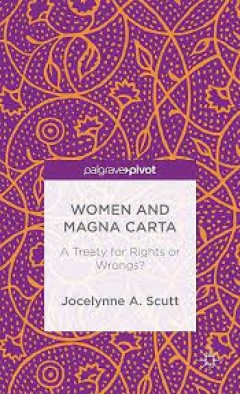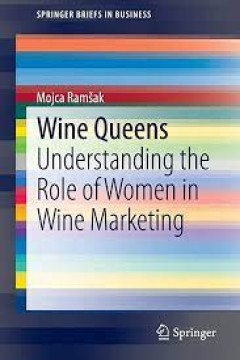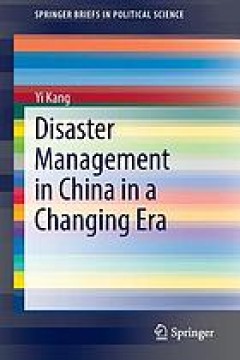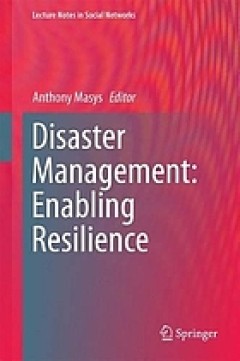Filter by

Women and The Magna Carta A Treaty for Control or Freedom
On the eight-hundredth anniversary of the Magna Carta, Women and the Magna Carta investigates what the charter meant for women's rights and freedoms from an historical and legal perspective.
- Edition
- -
- ISBN/ISSN
- 978-1-137-56235-7
- Collation
- -
- Series Title
- -
- Call Number
- -

Women and Aging An International, Intersectional Power Perspective
These are paradoxical times to be an older woman. As individual older women take the stage as role models in the arts and the public sphere, female elders as a group are marginalized as dependent, declining and unimportant. Women and Aging surveys the evolving sociopolitical landscape in an era still struggling with gender and age discrimination. This insightful volume recasts familiar conce…
- Edition
- -
- ISBN/ISSN
- 978-3-319-09306-2
- Collation
- -
- Series Title
- -
- Call Number
- -

Wine Queens Understanding the Role of Women in Wine Marketing
This book explores a fairly unique wine marketing topic by examining the role and historic function of Wine Queens and Wine Kings. The author charts the history of Wine Queens in Europe, the Americas and Asia, while also focusing on cases from Slovenia. The difference between Wine Queens and Beauty Queens is also described in light of marketing approaches used in the wine industry. The book con…
- Edition
- -
- ISBN/ISSN
- 978-3-319-16661-2
- Collation
- XIII, 49
- Series Title
- -
- Call Number
- -

We Are Coming Home Repatriation and the Restoration of Blackfoot Cultural Co…
In 1990, Gerald Conaty was hired as senior curator of ethnology at the Glenbow Museum, with the particular mandate of improving the museum’s relationship with Aboriginal communities. That same year, the Glenbow had taken its first tentative steps toward repatriation by returning sacred objects to First Nations’ peoples. These efforts drew harsh criticism from members of the provincial gover…
- Edition
- -
- ISBN/ISSN
- 9781771990172.01
- Collation
- -
- Series Title
- -
- Call Number
- 304 pages

Imagining Head-Smashed-In Aboriginal Buffalo Hunting on the Northern Plains
At the place known as Head-Smashed-In in southwestern Alberta, Aboriginal people practiced a form of group hunting for nearly 6,000 years before European contact. The large communal bison traps of the Plains were the single greatest food-getting method ever developed in human history. Hunters, working with their knowledge of the land and of buffalo behaviour, drove their quarry over a cliff and…
- Edition
- -
- ISBN/ISSN
- 9781897425046.01
- Collation
- -
- Series Title
- -
- Call Number
- 6.5 x 9.25, 361 pages

One Step Over the Line Toward a History of Women in the North American Wests
Sixteen essays arising from the “Unsettled Pasts: Reconceiving the West through Women’s History” conference at the University of Calgary comprise this foundational text. One Step Over the Line is not only the map; it is the bridgework to span the transnational, gendered divide—a must for readers who have been searching for a wide, inclusive perspective on our western past.
- Edition
- -
- ISBN/ISSN
- 9780888645012.01
- Collation
- -
- Series Title
- -
- Call Number
- 474 pages

Nightwood Theatre A Woman’s Work Is Always Done
In Nightwood Theatre, Scott describes the company’s journey toward defining itself as a feminist theatre establishment, highlighting its artistic leadership based on its relevance to diverse communities of women. She also traces Nightwood’s relationship with the media and places the theatre in an international context by comparing its history to that of like companies in the U.K. and the U.S.
- Edition
- -
- ISBN/ISSN
- 9781897425558.01
- Collation
- -
- Series Title
- Canadian Plays
- Call Number
- 344 pages

Disability Studies Educating for Inclusion
Education systems worldwide will only successfully serve the needs of people with disability when we inclusively examine and address disabling issues that currently exist at school level education as well as further and higher education and beyond. The chapters contributing to this edited volume are presented to assist readers with a critical examination of contemporary practice and offer a con…
- Edition
- -
- ISBN/ISSN
- 9789463001991
- Collation
- viii, 278 pages
- Series Title
- -
- Call Number
- 362.4

Disaster Management in China in a Changing Era
This book shows how Chinese officials have responded to popular and international pressure, while at the same time seeking to preserve their own careers, in the context of disaster management. Using the 2008 Wenchuan earthquake as a case study, it illustrates how authoritarian regimes are creating new governance mechanisms in response to the changing global environment and what challenges they …
- Edition
- -
- ISBN/ISSN
- 9783662445167
- Collation
- xvii, 126 pages
- Series Title
- -
- Call Number
- 363.348

Disaster Management: Enabling Resilience
The present work will discuss relevant theoretical frameworks and applications pertaining to enabling resilience within the risk, crisis and disaster management domain. The contributions to this book focus on resilience thinking along 4 broad themes: Urban Domain; Cyber Domain; Organizational/Social domain; and Socio-ecological domain. This book would serve as a valuable reference for courses o…
- Edition
- -
- ISBN/ISSN
- 9783319088198
- Collation
- xvi, 338 pages
- Series Title
- -
- Call Number
- 363.348
 Computer Science, Information & General Works
Computer Science, Information & General Works  Philosophy & Psychology
Philosophy & Psychology  Religion
Religion  Social Sciences
Social Sciences  Language
Language  Pure Science
Pure Science  Applied Sciences
Applied Sciences  Art & Recreation
Art & Recreation  Literature
Literature  History & Geography
History & Geography